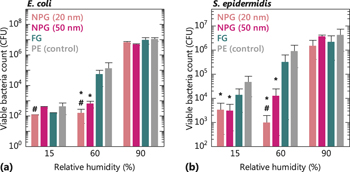Crossref Citations
This article has been cited by the following publications. This list is generated based on data provided by
Crossref.
Miyazawa, Naoki
Hakamada, Masataka
and
Mabuchi, Mamoru
2018.
Antimicrobial mechanisms due to hyperpolarisation induced by nanoporous Au.
Scientific Reports,
Vol. 8,
Issue. 1,
Deguchi, Soichiro
Hakamada, Masataka
Shingu, Jumpei
Sakakibara, Susumu
Sugiyama, Hironobu
and
Mabuchi, Mamoru
2019.
Inactivation of HeLa cells on nanoporous gold.
Materialia,
Vol. 7,
Issue. ,
p.
100370.
Miyazawa, Naoki
Sakakibara, Susumu
Hakamada, Masataka
and
Mabuchi, Mamoru
2019.
Electronic origin of antimicrobial activity owing to surface effect.
Scientific Reports,
Vol. 9,
Issue. 1,
Kang, Tae Yeon
Park, Kyeongsoon
Kwon, Seung Hae
and
Chae, Weon-Sik
2020.
Surface-engineered nanoporous gold nanoparticles for light-triggered drug release.
Optical Materials,
Vol. 106,
Issue. ,
p.
109985.
Miyazawa, Naoki
Hakamada, Masataka
and
Mabuchi, Mamoru
2020.
Effects of nanoporous Au on ATP synthase.
MRS Communications,
Vol. 10,
Issue. 1,
p.
173.
Hakamada, Masataka
Sakakibara, Susumu
Miyazawa, Naoki
Deguchi, Soichiro
and
Mabuchi, Mamoru
2020.
Antibacterial activity of ultrathin platinum islands on flat gold against Escherichia coli.
Scientific Reports,
Vol. 10,
Issue. 1,
Mortimer, Monika
Wang, Ying
and
Holden, Patricia A.
2021.
Molecular Mechanisms of Nanomaterial-Bacterial Interactions Revealed by Omics—The Role of Nanomaterial Effect Level.
Frontiers in Bioengineering and Biotechnology,
Vol. 9,
Issue. ,
Palanisamy, Barath
Goshi, Noah
and
Seker, Erkin
2021.
Chemically-Gated and Sustained Molecular Transport through Nanoporous Gold Thin Films in Biofouling Conditions.
Nanomaterials,
Vol. 11,
Issue. 2,
p.
498.
Saidin, Syafiqah
Jumat, Mohamad Amin
Mohd Amin, Nur Ain Atiqah
and
Saleh Al-Hammadi, Abdullah Sharaf
2021.
Organic and inorganic antibacterial approaches in combating bacterial infection for biomedical application.
Materials Science and Engineering: C,
Vol. 118,
Issue. ,
p.
111382.
Deguchi, Soichiro
Kato, Atsushi
Wu, Peizheng
Hakamada, Masataka
and
Mabuchi, Mamoru
2021.
Heterogeneous role of integrins in fibroblast response to small cyclic mechanical stimulus generated by a nanoporous gold actuator.
Acta Biomaterialia,
Vol. 121,
Issue. ,
p.
418.
Hakamada, Masataka
2022.
Old and new nanomaterials: nanoporous metals.
Journal of Japan Institute of Light Metals,
Vol. 72,
Issue. 2,
p.
58.
Widakdo, Januar
Chen, Tsan-Ming
Lin, Meng-Chieh
Wu, Jia-Hao
Lin, Tse-Ling
Yu, Pin-Ju
Hung, Wei-Song
and
Lee, Kueir-Rarn
2022.
Evaluation of the Antibacterial Activity of Eco-Friendly Hybrid Composites on the Base of Oyster Shell Powder Modified by Metal Ions and LLDPE.
Polymers,
Vol. 14,
Issue. 15,
p.
3001.
Smith, J.L.
Tran, N.
Song, T.
Liang, D.
and
Qian, M.
2022.
Robust bulk micro-nano hierarchical copper structures possessing exceptional bactericidal efficacy.
Biomaterials,
Vol. 280,
Issue. ,
p.
121271.
Wu, Peizheng
Yanagi, Kazuya
Yokota, Kazuki
Hakamada, Masataka
and
Mabuchi, Mamoru
2023.
Unusual effects of a nanoporous gold substrate on cell adhesion and differentiation because of independent multi-branch signaling of focal adhesions.
Journal of Materials Science: Materials in Medicine,
Vol. 34,
Issue. 11,
Teplyakova, Tatyana O.
Konopatsky, Anton S.
Iakimova, Tamara M.
Naumova, Alena D.
Permyakova, Elizaveta S.
Ilnitskaya, Alla S.
Glushankova, Natalia A.
Karshieva, Saida Sh.
Ignatov, Sergey G.
Slukin, Pavel V.
Prokoshkin, Sergey D.
and
Shtansky, Dmitry V.
2024.
Antibacterial properties, biocompatibility and superelastic behavior of Au-cysteine-gentamicin-functionalized Ti–Zr–Nb alloy.
Materials Today Chemistry,
Vol. 36,
Issue. ,
p.
101948.
